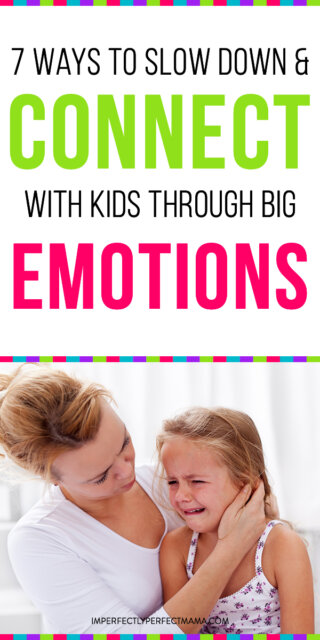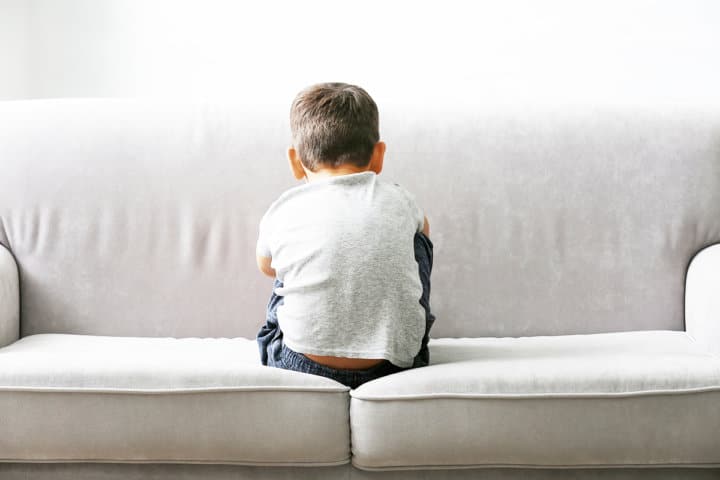My daughter had a really rough start to the day—she didn’t get a good night’s sleep, so we experienced a lot of turbulence this morning.

She’s 3, so really, these days happen a lot.
First she cried because I asked her to take a bath, then she cried because nobody could hold her at that exact moment and then she cried because the bubbles in the bubble mailer I gave her wouldn’t pop.
It was a very tragic sight, and I could see my partner’s patience wearing thin as she clung to his t-shirt, howling between sobs.
Normally I would be just as frazzled as him, if not more, because I’m working from home.
I’m taking care of the kids and the house by myself five days out of the week while he is off working around other adults, chatting with other adults, having complete autonomy and not dealing with any bodily fluids.
Do I sound a little bitter? Nahhhh… 🙂
We are imperfectly perfect mamas, right?
In this particular situation, I was able to slow down and remember that my daughter’s current big emotions aren’t something she can control yet.
It was the perfect opportunity for me to connect with her and help her through it.
So I mentally shuffled through all of the parenting courses, psychology classes and coaching techniques I learned over the years and pulled a few of those tools from the rusty, dusty toolbox.
I didn’t “fix” the situation, but what I did accomplish has farther-reaching benefits.
We’ve all experienced the frustration and hopelessness of our child’s big emotions.
Sometimes our energy is depleted and we get down-right infuriated.
Here are some tools to turn the next big emotional episode into a teachable moment for all parties involved!
1. Understand How a Child’s Brain Works During Big Emotions
I have a dry-erase board mounted in my kitchen solely for inspirational quotes. I’m a total nerd mom, I know.
One of my favorite quotes on there is, “Behavior is not the problem—it’s the symptom.”—unknown
Mind blowing, right? So simple, but so profound!
Here is an example: I have struggled with adult acne since my daughter was born. I break out particularly bad around my chin, but I didn’t have this problem before my daughter graced me with her beautiful presence.
In fact, I never used face wash or cleansers or fancy creams or any of that!
I washed with warm water, splashed with cold, and finished with a bit of aloe vera gel. Weird, but it worked for me—I had radiant, youthful skin.
Until I didn’t.
My first response was to change up my routine—I tried new creams, serums, masks, and even started using cleansers again. But nothing made my skin better.
In fact, it got worst.
I was treating the symptom, not the root cause.
Turns out I had mold toxicity and a hormonal imbalance that were impacting way more than just my skin. But I may never have figured that out if the creams, serums, masks or cleansers hadn’t been totally ineffective!
I wasted a lot of time and money going down the rabbit hole of quick fixes, but I learned from it.
The same applies to our parenting!
How often do we take time to think beyond the negative behavior to what could actually be going on with our child? Now is the time to start.
When it comes to certain big emotions, like meltdown tantrums, our kiddos just cannot self-regulate.
According to Dr. Daniel J. Siegel, there are two types of tantrums: upstairs/manipulative tantrums, and downstairs/meltdown tantrums.
During upstairs/manipulative tantrums, your child has a goal. They are intentionally using their emotional hurricane powers to get something they want.
This is called the “upstairs” tantrum because your child is using their higher thinking in an attempt to control you instead of themselves.
During downstairs/meltdown tantrums, your child is operating from their impulses and unable to regulate their own emotions.
Something is off in their basic needs bucket—maybe they didn’t sleep well, they’re getting hungry, they’re overheated, cold, or perhaps they are sick.
Whatever the case, it’s pushed them over the edge and they can’t access their upstairs thinking.
They are at the mercy of their emotions.
And so are you, but you don’t have to be!
2. How Our Parenting Styles Can Clash With Kids
I took a parenting course last year that I found very enlightening.
In it, they discuss The 3 Ego States, based on Eric Berne’s Transactional Analysis theory:
- Parent Ego State—when we are in a position of authority, or ordering, correcting, and directing.
- Adult Ego State—non-emotional, thinking, reasoning, and processing information.
- Child Ego State—high emotion and impulsivity, can be positive or negative.
Which ego state do you think we tend to operate from the most? Probably the Parent Ego State.
Which ego state do you think our children enjoy time with us the most? Definitely the Child Ego State.
In the Child Ego State we are carefree, laughing, enjoying life and also making the strongest connections with our child.
Now, let’s talk about the Adlerian Personality Priority:
- Superiority—corrects others, feels superior, models success & confidence, has high expectations.
- Controlling—rigid and controlling, models organization & leadership, operates from Parent Ego State.
- Pleasing—people-pleaser, yes-person, avoids conflict, takes on responsibility of others.
- Comforting—easy-going, may lack rules and limits, doesn’t stick to routines, permissive.
Most people who have superiority as their personality priority, will have controlling as their secondary and vice versa. The same goes for pleasing and comforting.
What do you identify with? I have superiority/controlling as my personality priorities.
So, if I don’t make a conscious effort to balance that out with some pleasing and comforting, the people I love might begin to feel inadequate, unappreciated, unloved and bossed-around. Plus, I’m inviting power struggles.
On the other hand, a person with pleasing/comforting as their personality priorities may have kids who aren’t able to take on responsibilities for themselves and feel out of control because they lack a routine.
That parent may feel resentful if they are always saying yes, giving in, and letting other people walk all over them to avoid conflict.
Can you see how leaning too much into one set of personality priorities can lead to dysfunction?
We need balance and so do our kids!
Key takeaways: Spend more time in the Child Ego State, less time in the Parent Ego State. Identify your personality priority and work on balancing it out.
3. Why It Is Important to Label Emotions

As parents, we have the privilege of being first responders to our kids’ feelings and behaviors.
That means we have a duty to help them understand those feelings and behaviors.
While children experience the same complex emotions that us adults do, young kids don’t have the vocabulary to name them and older kids may not have the emotional skills to express them in healthy ways.
How frustrating must that be?
This is why our toddlers often scrunch up their faces, throw things, hit or scream, while our school-aged kids get in fights or act out at school, and our teens withdraw, seek acceptance from the wrong crowds, and turn to drugs and other illegal activity.
Kids who learn healthy & constructive ways to manage their feelings are more likely to:
- Have positive attitudes and behaviors later in life
- Develop resilience and coping skills
- Display less behavioral problems
- Feel competent, confident, and capable
- Express empathy and concern for others
- Have positive, stable relationships
- Have better mental health & well being
- Perform better in school and in their career
- Have a strong, positive sense of self
“Giving something a name allows us to make sense of it and helps us manage it in a healthy way.”—Dr. Sarah Watamura
Helping our children identify their emotions is the first step to teaching them how to positively manage them.
When teaching your kids to identify their emotions, get specific. Don’t use general terms like sad, mad, happy, bad.
4. Understand Emotional Sandbags & Flooding
Have you ever had one of those days/weeks/months/years where you are just overwhelmed but don’t have the time to let it all out?
Maybe you don’t have a place to let it all out—you’re a single mom, or your partner doesn’t listen, or you drifted away from your friends after you had kids.
Whatever the reason, those feelings build up like carbonation in a shaken soda bottle.
The pressure is heavy, like a sandbag on your chest.
And instead of having someone gently lift the sandbag off your chest, the pressure reaches maximum capacity and your lid blows at the worst possible time. You totally explode “over nothing.”
Now you have a flood on your hands.
Whoever is unlucky enough to be in your path gets hit by the tsunami.
You feel partly relieved, but mostly guilty and the response from the other person makes you feel worst.
“What did I do to deserve that!?”
You don’t even know and you’re too exhausted to figure it out. You just want to lay down and nurse that wicked headache.
Do you see what went wrong here? It wasn’t your fault.
We all need someone to help us lift those emotional sandbags off our chests.
Sometimes we can do it ourselves, but that takes a lot of practice, resilience, and determination. It’s more than okay to lean on the people around us—it’s healthy.
Kids definitely need help letting go of their emotional sandbags so their feelings don’t come through the flood gates in disastrous amounts.
Need tips on how to do that? No worries, keep reading!
5. Common Communication Conundrums
Communication can make or break our relationships, especially with our kids.
Most of us don’t realize that the communication skills we picked up throughout our lives are super ineffective and often hurtful.
Ineffective communication is one of the biggest blocks holding us back from deep, meaningful connections.
Here are the common communication conundrums:
Being Distracted
Allowing distractions while your child is attempting to communicate with you tells them that they do not matter.
It sends the message that they are not important, their feelings are not important, and you would rather be doing something else than actively listening to them.
Listening Just to Respond
If your brain is busy planning out what you are going to say while your child is opening up to you, you are not actively listening and your child will most likely recognize this as soon as you start talking—maybe sooner.
They’ll likely feel misunderstood and ignored.
Interrupting
I think we all know how annoying this one is, and for some of us with squirrel brain, it may be very challenging to overcome.
But it’s also harmful to our relationships with our kids and worth the extra effort to stop ourselves from doing.
Reasoning
When your child is upset about something, trying to reason with them is not helpful.
You can’t force logical thinking when your child is not using their higher brain, or when they just want to feel heard.
Siding With the Enemy
If you haven’t personally experienced this from your own parents, let me tell you—it stinks. Whether your child is right or wrong, siding with the enemy is usually a mistake.
When your child is feeling their feelings, siding with the enemy is really just another form of reasoning.
Ignoring Their Feelings
A commonly perpetuated myth is that children need to change their negative emotions.
Guess how disregarding your child’s actual feelings and telling them how they should feel makes them really feel? Ignored.
They may also think their feelings are wrong, inappropriate, or that they don’t know how to have feelings. This can lead to a lot of heartache and pretending that everything is okay when it isn’t.
Trying to be “The Fixer”
This falls in line with reasoning and ignoring feelings.
When we try to fix our child’s emotional state, we are sending the message that it’s not okay to experience negative emotions and that we aren’t comfortable with their negative emotions.
Just like ignoring feelings, this can lead to faking a positive attitude and becoming a people-pleaser.
6. Powerful & Effective Communication

So, how do we turn those destructive communication patterns around?
We adopt these powerful, effective communication techniques instead:
Engage in Active Listening
Many of us believe we are talented multi-taskers, but the truth is, less is more. Especially where communication with our kids is concerned.
The next time your child approaches you with a concern or problem, set your phone down. Close your laptop. Put down the book, pause the TV, let the dishes soak for a minute… you get the idea.
It’s super important that your child knows you are there for them, you are really listening, and you really care.
Even if you think they are being ridiculous or their problem is inconsequential. To them, it isn’t.
We might have situations where we can’t stop what we are doing, but we can let them know that we will set aside time for them as soon as possible so we can be really present.
But, if you have the power to stop what you are doing and really focus in on them, it will make all the difference to them.
Sometimes that is all it takes to bring their big emotions down a few notches. But even if it doesn’t, your undivided attention in their moment of need will not go unnoticed.
Don’t forget to make eye-contact!
Respond Rather than React
Remember how we talked about interrupting and listening just to respond? Here’s a trick to help you with those: practice taking a pause and deep breath before you respond.
This not only demonstrates for your child how to slow down and think before formulating a response, but it also gives you a moment to really consider what your child needs from you.
Most likely, they need you to empathize and help them feel understood.
This can also help you refrain from turning to punishment. Timeouts are ineffective long-term and punishing kids for having negative emotions is damaging.
Slowing down and taking a pause before responding to big emotions can really make a difference!
Empathize Rather Reason or Reassure
This one might get met with resistance, but hear me out!
Telling our children that everything is okay, everything will be okay, or that they can handle something they are stressing over does not make them feel better.
You can’t control your child’s anxiety or big emotions.
Let me say that again—you cannot control your child’s emotions.
Reassurance is nothing more than a thinly-veiled attempt at control. We all mean well, but you know what they say about good intentions.
And when we use reassurance and reasoning, it’s the same as being a “fixer.” Our children only hear that their feelings of worry, doubt, or insecurity shouldn’t exist. They will find other ways to express these feelings—including tantrums, acting out, and repressing them.
So instead, try empathizing and help them label their emotions.
“You must feel really betrayed by what your friend said about you. I’m so sorry. It wasn’t nice of her and you’ve been a really good friend. I’m really disappointed in her.”
or
“I can see you’re feeling frustrated that you can’t have a cookie right now. I would be frustrated if I were you, too. I know you really like cookies and it doesn’t seem fair that I told you no.”
Obviously, you aren’t going to budge on that cookie. But letting your toddler know that you understand how they are feeling and verbalizing it for them helps them label their emotions and shows them you hear them and you understand what they are feeling, even if you are sticking to your guns.
And when your school-aged kid is having a spat with their best friend, you may be tempted to smooth things over and help them see it from the friend’s point of view.
Try to avoid that, focus on how your child is feeling and how you can help them feel heard and understood.
Help Them Leverage Their Emotions
Rather than seeking to control a child’s emotions, help them learn how to leverage them.
This can be as simple as turning their episodes of big emotions into a teachable moment after all is calm and they can talk about it.
You can discuss what they were feeling, what triggered those feelings, and how they reacted.
Then you can have them brainstorm ideas on how they can react differently to their feelings next time.
We don’t want to shame them here—we want to educate them on the positive and constructive ways to deal with their feelings.
Be their guide. Tap into your zen, and speak with heart-centered advice.
7. The Difference Between Short-term & Long-term Happiness

Did you know that the things you think make you happy… are actually decreasing your long-term happiness?
That new house, your favorite food, that cup of coffee, and every time you get a notification from social media—you may think some of these things are vital to your happiness, but they’re not.
I see all you caffeine addicts glaring me down!
But for just a minute, let’s forget that I called you out and you’re still paying attention.
The reason we think those things bring us real happiness is because we get a hit of the chemical dopamine every time we have one of those little boosts of pleasure.
This is also true for our kids. When they are experiencing negative emotions and when we consistently give them ice cream, candy, a phone to play on, or plop them in front of the TV to calm them down—we are only giving them a rush of dopamine.
Sure, they may feel better right then, but at the cost of their long-term happiness.
It’s like putting a band-aid on a festering wound. It’ll cover it up, but that wound isn’t going to stop festering. It may just lead to sepsis.
I know that’s an ugly metaphor and maybe a bit over the top… but it’s kind of accurate.
Here’s why.
The problem with dopamine is that it is very short-lived and it actually decreases our long-term happiness and ability to form deep emotional bonds with loved ones.
Kids who don’t have deep emotional bonds with loved ones are more likely to experience high levels of cortisol, “the stress hormone.”
Children with consistent high levels of cortisol are more likely to turn to substance abuse, crime, make poor choices, and have unhappy lives. They are also more likely to experience cognitive delays and learning deficits.
So, how do we ensure our kids have balanced cortisol?
By increasing oxytocin! Have I lost you yet? Hang in there!
Oxytocin is the chemical that increases our long-term well-being.
How do we increase oxytocin?
By building deep bonds within safe relationships. 🙂
Let’s Wrap This Up!
While you won’t see the results of oxytocin immediately, know that you are increasing it over time by building deep bonds with your children.
And building deep bonds with your children doesn’t have to be complicated or taxing—in fact, it can be incredibly rewarding. All you gotta do is start using the tools above.
The beautiful thing about these tools is that they can be used to deepen connections in any of your relationships!
Just don’t let your toolbox get rusty and dusty like I did. 😉




1 Comments